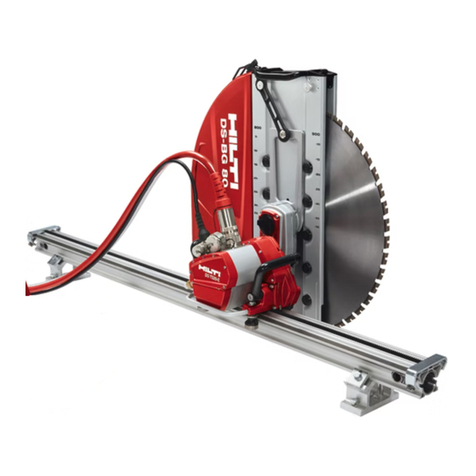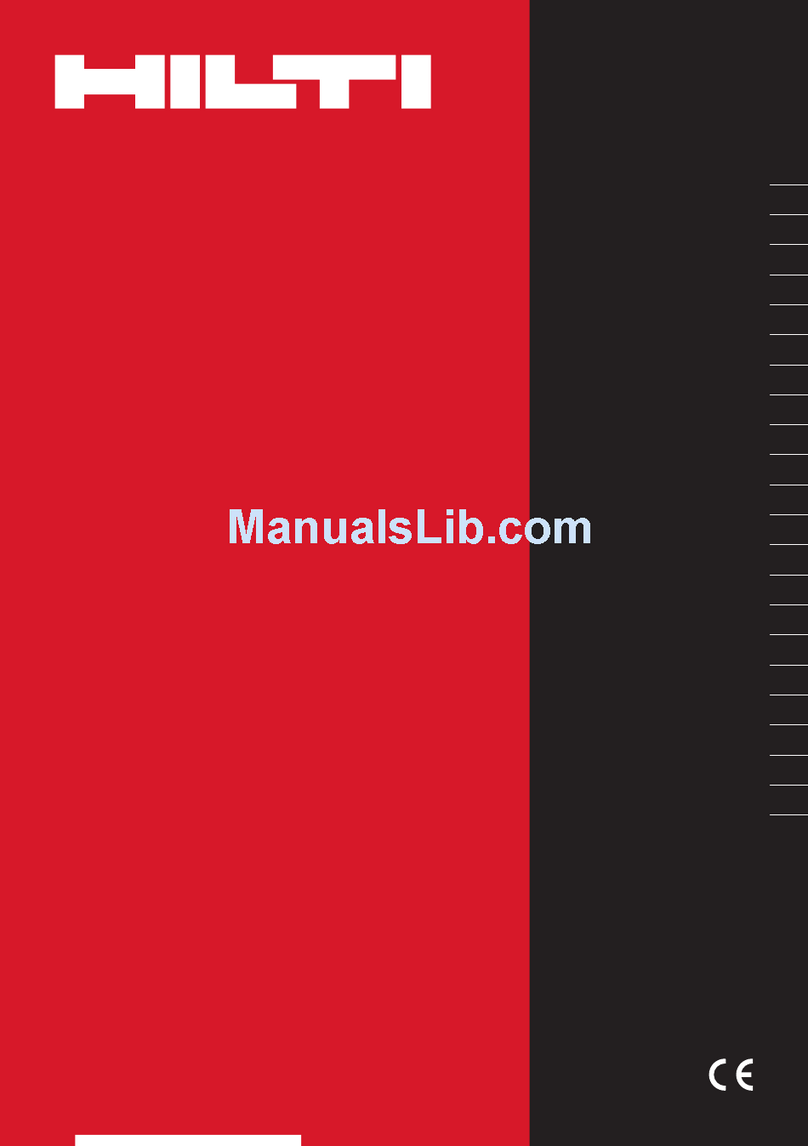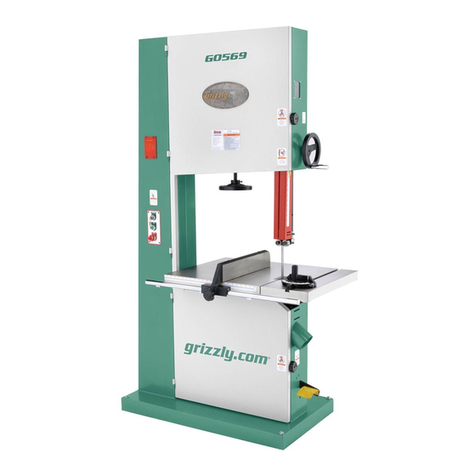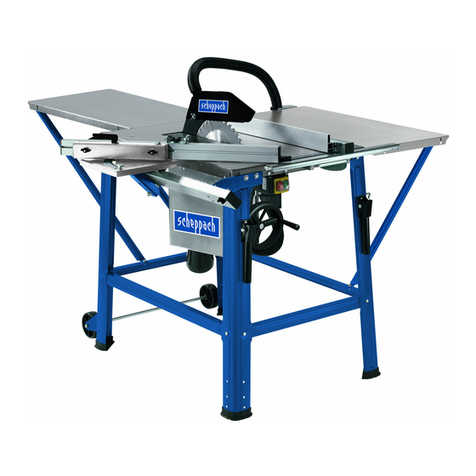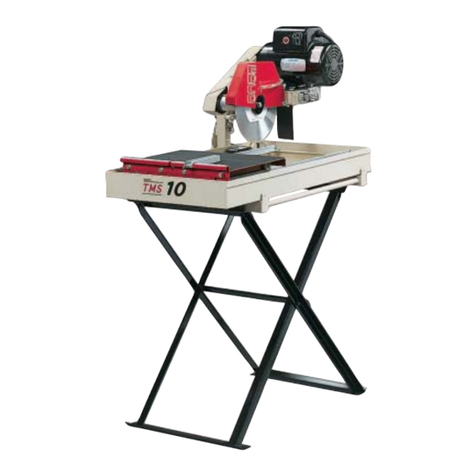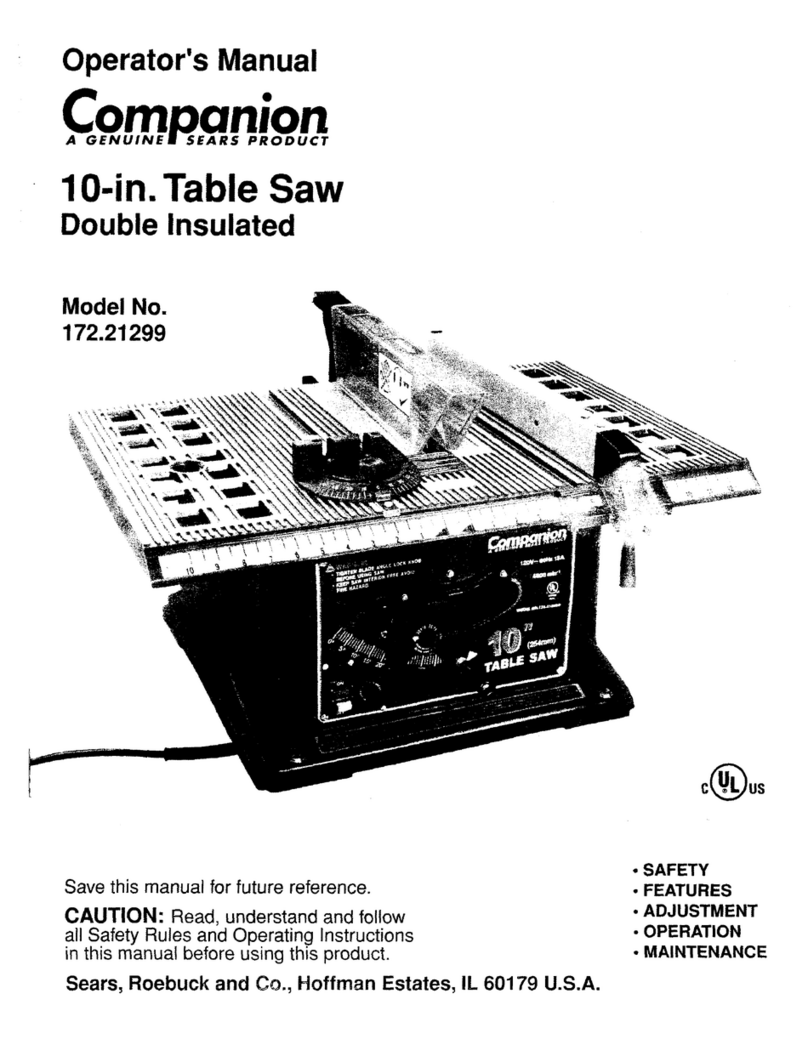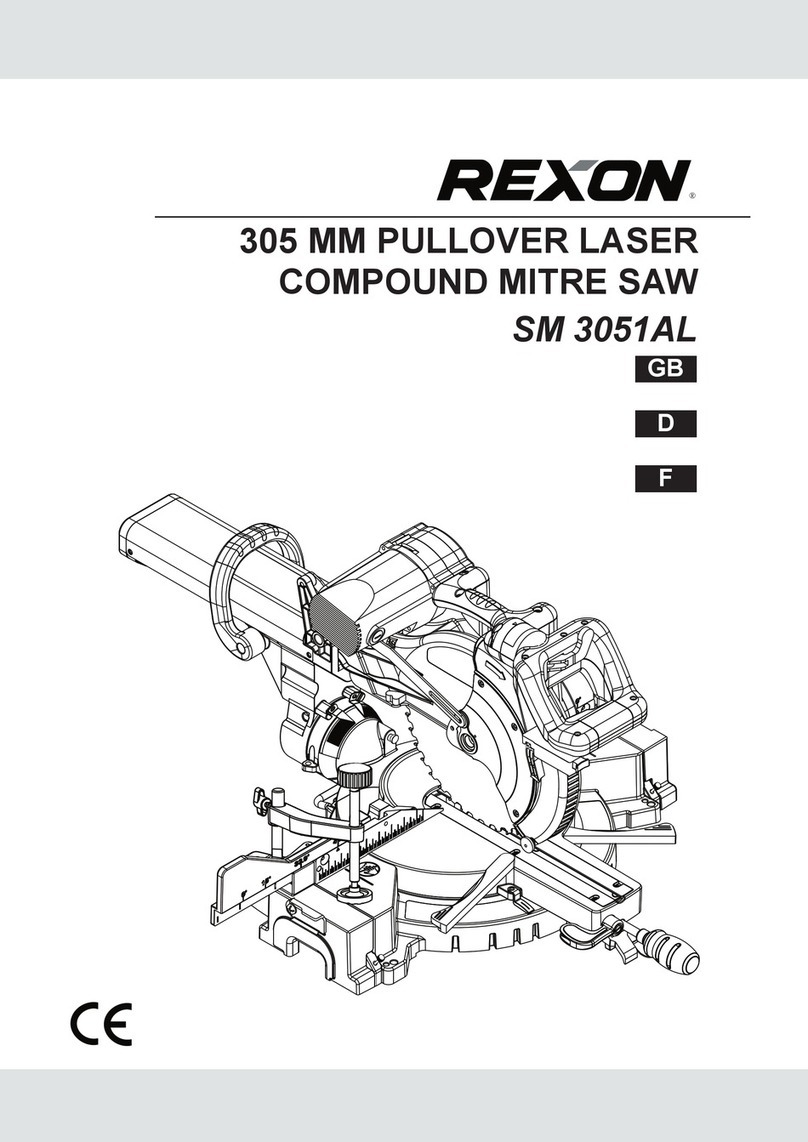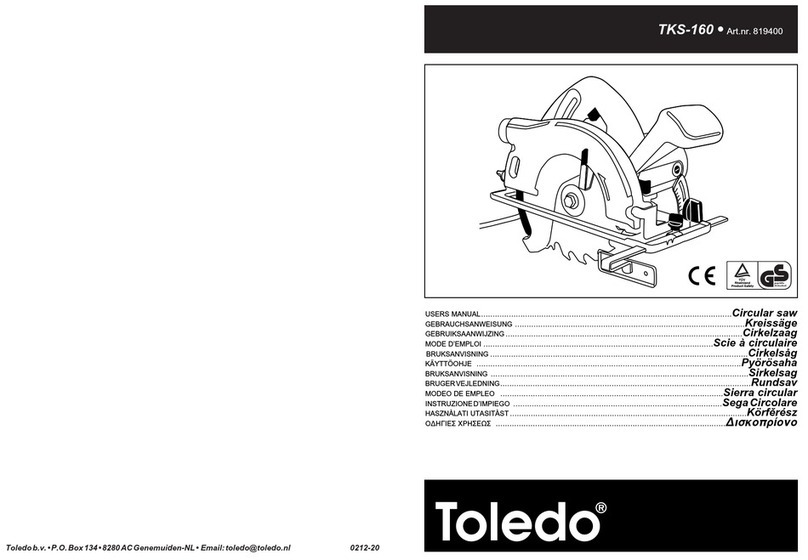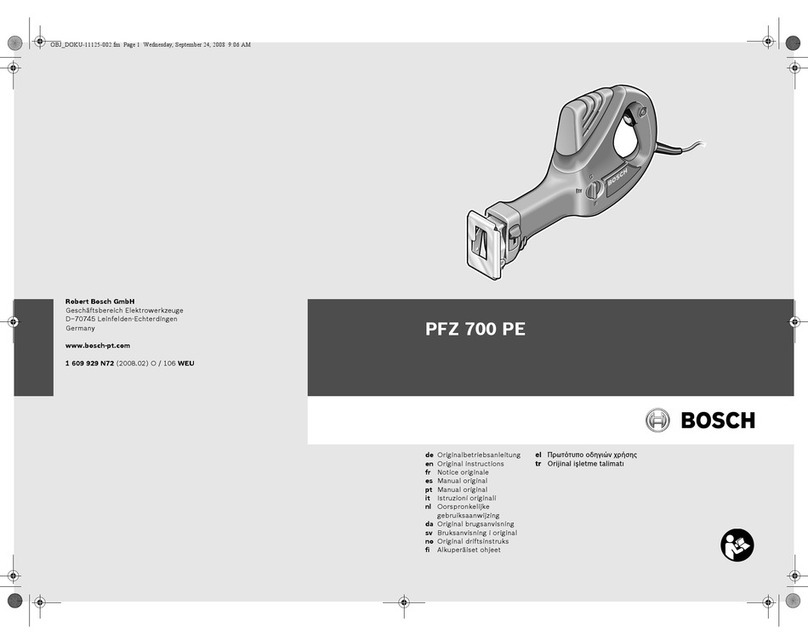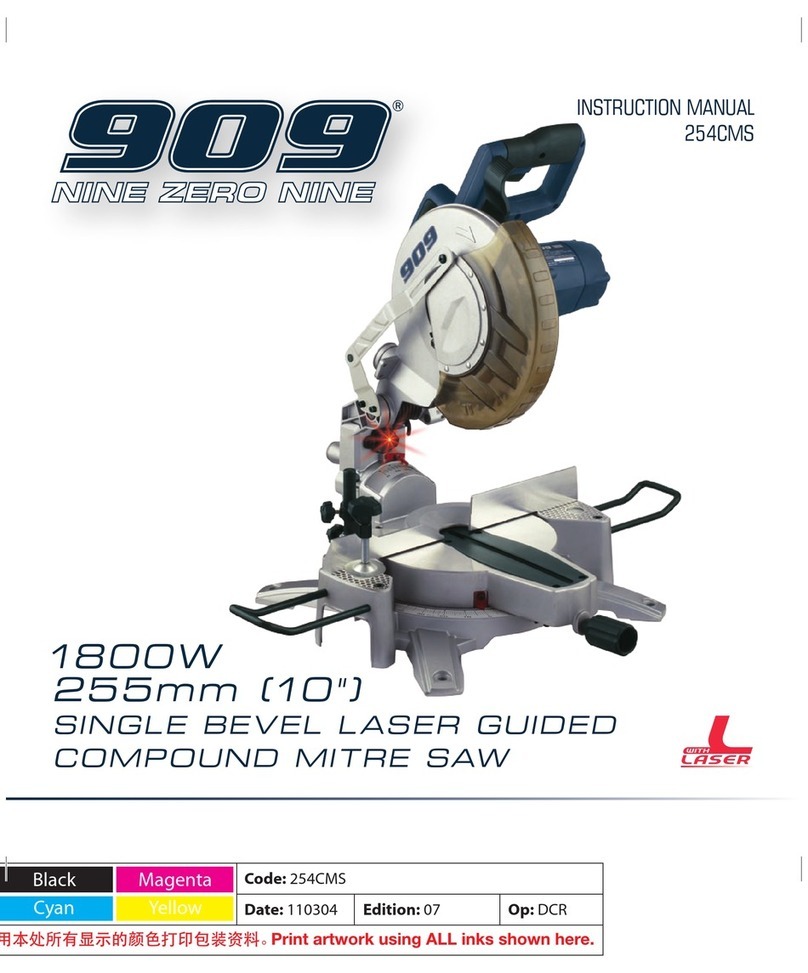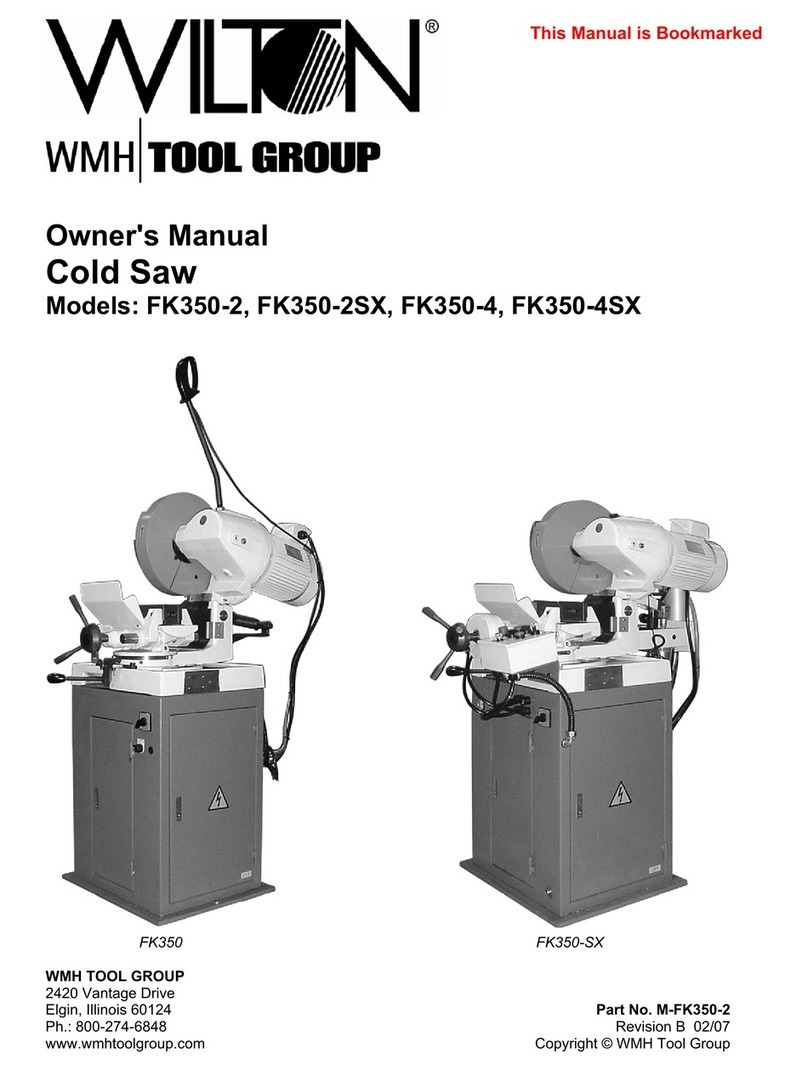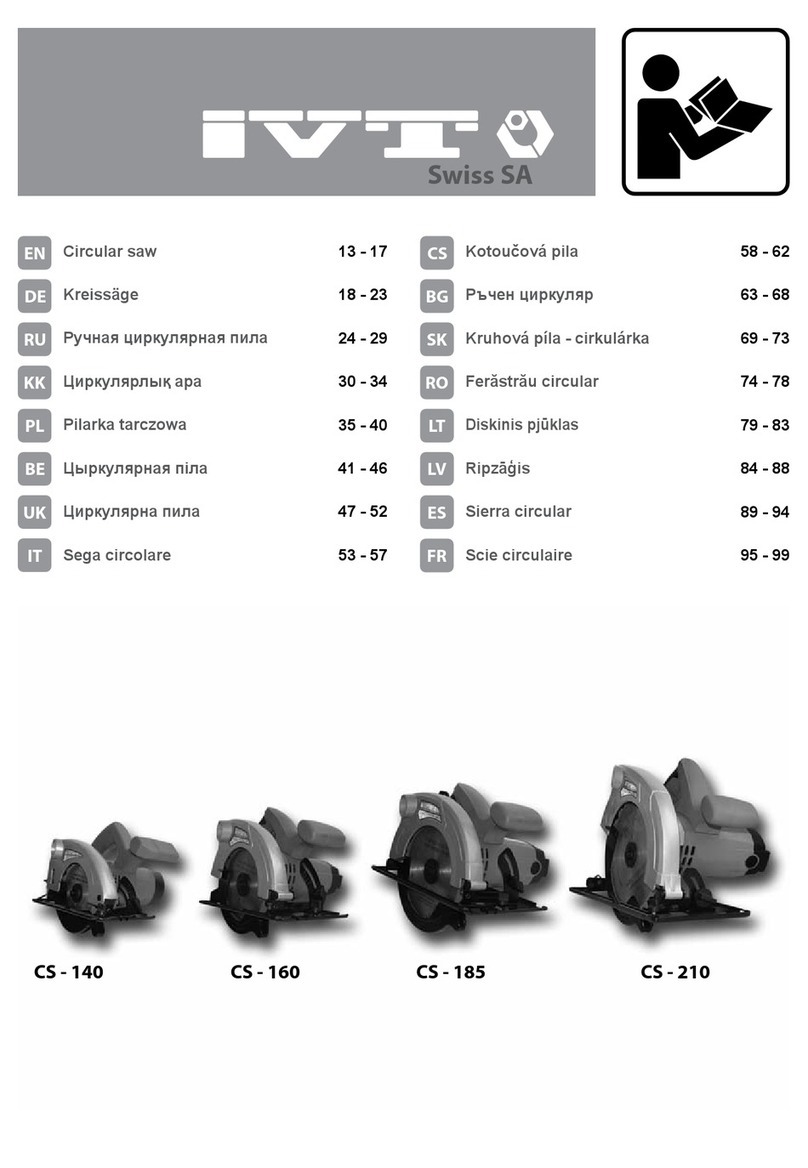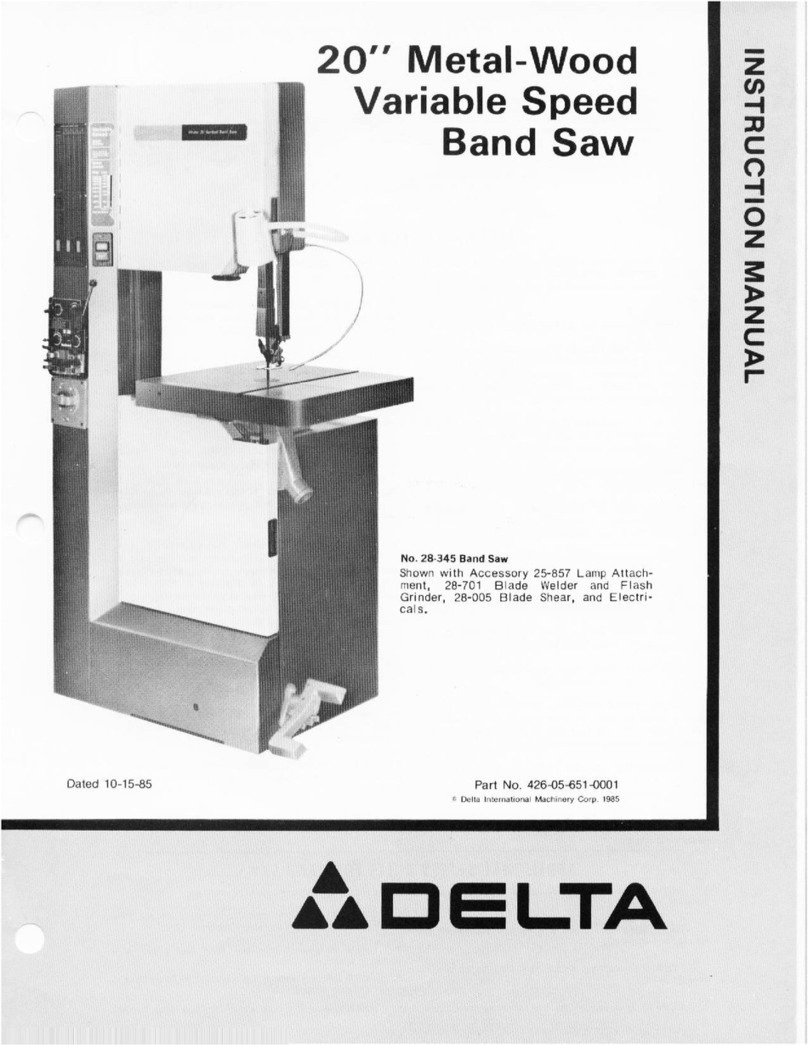Hilti WSR 900-PE User manual

Bedienungsanleitung de
Operating instructions en
Mode d’emploi fr
Istruzioni d’uso it
Gebruiksaanwijzing nl
Manual de instruções pt
Manual de instrucciones es
Brugsanvisning da
Käyttöohje fi
Bruksanvisning no
Bruksanvisning sv
Οδηγιες χρησεως el
ar
Kasutusjuhend et
Instrukcija lt
Lietošanas pamācība lv
WSR 900-PE
WSR 1250-PE
WSR 1400-PE
Printed: 21.08.2013 | Doc-Nr: PUB / 5138037 / 000 / 01

1
Printed: 21.08.2013 | Doc-Nr: PUB / 5138037 / 000 / 01

2
3
4
5 6
Printed: 21.08.2013 | Doc-Nr: PUB / 5138037 / 000 / 01

7 8
9
10
Printed: 21.08.2013 | Doc-Nr: PUB / 5138037 / 000 / 01

11
12
13 14
15 16
Printed: 21.08.2013 | Doc-Nr: PUB / 5138037 / 000 / 01

13
en
It is essential that the operating instructions
are read before the tool is operated for the
first time.
Always keep these operating instructions
together with the tool.
Ensure that the operating instructions
are with the tool when it is given to other
persons.
WSR 900-PE / WSR1250-PE / WSR1400-PE
reciprocating saw
1. General information
1.1 Signal words and their meaning
-WARNING-
The word WARNING is used to draw attention to a poten-
tially dangerous situation which could lead to severe
personal injury or death.
-CAUTION-
Used to draw attention to a potentially dangerous situa-
tion which could lead to minor personal injury or dam-
age to the equipment or other property.
-NOTE-
Used to draw attention to an instruction or other useful
information.
1.2 Pictograms
Contents Page
1. General information 13
2. Description 14
3. Blades and accessories 15
4. Technical data 15
5. Safety rules 16
6. Before use 18
7. Operation 19
8. Care and maintenance 21
9. Troubleshooting 21
10. Disposal 22
11. Manufacturer's warranty – tools 22
12. EC declaration of conformity (original) 22
Operating controls and parts
햲Blade clamp / blade holder
햳Orbital action selector switch
햴Stroke rate regulator
(only WSR 900-PE / WSR 1400-PE)
햵Transport lock
햶Control switch
햷Type plate
햸Motor
햹Gearing section
햺Front-end grip area (hand guard)
햻Hand guard with blade holder cover
햽Lockbutton for adjusting the contact shoe
햾Contact shoe
햿Saw blade
These numbers refer to the corresponding illustra-
tions. The illustrations can be found on the fold-out cover
pages. Keep these pages open while studying the oper-
ating instructions.
In these operating instructions, the WSR 900-PE / WSR
1250-PE / WSR 1400-PE reciprocating saw is referred
to as "the tool".
Warning signs
General
warning
Warning:
electricity
Warning:
hot surface
Obligation signs
Wear
ear
protection
Wear
protective
gloves
Wear
breathing
protection
Wear
eye
protection
Read the
operating
instructions
before use.
Symbols
Return waste
material for
recycling
ORIGINAL OPERATING INSTRUCTIONS
Wear a hard
hat
Printed: 21.08.2013 | Doc-Nr: PUB / 5138037 / 000 / 01

14
en
2. Description
2.1 Use of the WSR 900-PE as directed
●Typical working environments include rescue services,
public authorities, farming and forestry, general con-
struction, renovation and conversion work, metal con-
struction, plumbing / heating / air-conditioning instal-
lation trades, in workshops and on construction sites.
●The tool may be used for cutting wood, wood-like
materials, metals and plastics.
●The tool must be used in a dry environment.
●The tool may be powered only by an electric supply
voltage in compliance with the information given on
the type plate.
●The tool is designed for two-handed operation.
●Use only the blades and accessories listed in the oper-
ating instructions.
●Do not use the tool to cut bricks, concrete, cellular
concrete, natural stone or tiles.
●Do not use the tool in a damp environment.
●Do not use the tool in environments where there is a
risk of explosion.
●Do not use the tool to cut pipes that still contain liq-
uids.
●Do not cut into unknown materials.
●Use the tool within its intended cutting performance
range and with suitable blades (do not use blades of
the wrong size or reciprocating saw blades not equipped
with a 1/2" connection end).
●Cutting materials containing asbestos is not permis-
sible.
●Changes or modifications to the tool are not permissible.
●To avoid the risk of injury, use only original Hilti acces-
sories and additional equipment.
●Observe the information printed in the operating instruc-
tions concerning operation, care and maintenance.
●The tool is intended for professional use.
●The tool may be operated, serviced and repaired only
by authorized, trained personnel. This personnel
must be informed of any special hazards that may
be encountered.
●The tool and its ancillary equipment may present haz-
ards when used incorrectly by untrained personnel or
when used not as directed.
-WARNING-
Before cutting pipes, always first ensure that the pipes
contain no liquids. Empty the pipes if necessary. The
tool is not water or moisture proof. Liquids running out
may cause a short circuit in the tool resulting in an elec-
tric shock being received. When cutting pipes, hold the
tool so that it is higher than the pipe being cut.
2.2 Use of the WSR 1250-PE / WSR 1400-PE as
directed
●Typical working environments include general con-
struction, renovation and conversion work, metal con-
struction, plumbing / heating / air-conditioning instal-
lation trades, rescue services, public authorities,
farming and forestry, in workshops and on construc-
tion sites.
●The tool may be used for cutting wood, wood-like
materials, metals, plastics, bricks, cellular concrete
and tiles.
●The tool must be used in a dry environment.
●The tool may be powered only by an electric supply
voltage in compliance with the information given on
the type plate.
●The tool is designed for two-handed operation.
●Use only the blades and accessories listed in the oper-
ating instructions.
●Do not use the tool to cut concrete or natural stone.
●Do not use the tool in a damp environment.
●Do not use the tool in environments where there is a
risk of explosion.
●Do not use the tool to cut pipes that still contain liq-
uids.
●Do not cut into unknown materials.
●Use the tool within its intended cutting performance
range and with suitable blades (do not use blades of
the wrong size or reciprocating saw blades not equipped
with a 1/2" connection end).
●Cutting materials containing asbestos is not permis-
sible.
●Changes or modifications to the tool are not permissible.
●To avoid the risk of injury, use only original Hilti acces-
sories and additional equipment.
●Observe the information printed in the operating instruc-
tions concerning operation, care and maintenance.
●The tool is intended for professional use.
●The tool may be operated, serviced and repaired only
by authorized, trained personnel. This personnel
Location of identification data on the tool
The type designation and serial number can be found on
the rating plate on the tool. Make a note of this data in
your operating instructions and always refer to it when
making an enquiry to your Hilti representative or service
department.
Type:
Serial no.:
Printed: 21.08.2013 | Doc-Nr: PUB / 5138037 / 000 / 01

15
en
3. Blades and accessories
Saw blades
Pipe cutting adaptor
Side handle / Side handle adaptor
4. Technical data
Tool WSR 900-PE WSR 1250-PE WSR 1400-PE
Nominal power rating 900 W 1250 W 1400 W
Nominal voltage * 110 V / 8.5 A 110 V / 12.5 A 110 V / 13.4 A
Nominal current input * 120 V / 8.5 A 120 V / 12 A 120 V / 13 A
220 V / 4.3 A 220 V / 6 A 220 V / 6.4 A
230 V / 4.1 A 230 V / 6 A 230 V / 6.4 A
240 V / 4.2 A 240 V / 5.8 A 240 V / 6.2 A
Mains frequency 50 / 60 Hz 50 / 60 Hz 50 / 60 Hz
Weight in accordance with EPTA
procedure 01/2003 3.6 kg 4.5 kg 4.8 kg
Dimensions (L×B×H) 442×88×211 mm 493×101×180 mm 574×101×188 mm
Stroke rate 0–2700 min–1 0–2700 min–1 0–2700 min–1
Stroke 32 mm 32 mm 32 mm
Stroke rate regulation Constant-speed elec- Constant-speed elec- Constant-speed elec-
tronics with variable tronics with variable tronics with variable
stroke rate, stroke rate stroke rate stroke rate, stroke rate
regulator with 6 pos. regulator with 6 pos.
Blade clamp Keyless, for standard 1/2″blades
Orbital action on / off
Double insulated (in accordance with EN 60745) Protection class II (double insulated) Z
must be informed of any special hazards that may
be encountered.
●The tool and its ancillary equipment may present haz-
ards when used incorrectly by untrained personnel or
when used not as directed.
-WARNING-
Before cutting pipes, always first ensure that the pipes
contain no liquids. Empty the pipes if necessary. The
tool is not water or moisture proof. Liquids running out may
cause a short circuit in the tool resulting in an electric shock
being received. When cutting pipes, hold the tool so that it
is higher than the pipe being cut.
2.3 The items supplied include:
– Reciprocating saw includingcontact shoe and saw blade
– Operating instructions
– Toolbox
NOTE
The vibration emission level given in this information sheet has been measured in accordance with a standardised
test given in EN 60745 and may be used to compare one tool with another. It may be used for a preliminary asses-
sment of exposure. The declared vibration emission level represents the main applications of the tool. However if
the tool is used for different applications, with different accessories or poorly maintained, the vibration emission
may differ. This may significantly increase the exposure level over the total working period. An estimation of the
level of exposure to vibration should also take into account the times when the tool is switched off or when it is
running but not actually doing the job. This may significantly reduce the exposure level over the total working peri-
od. Identify additional safety measures to protect the operator from the effects of vibration such as: maintain the
tool and the accessories, keep the hands warm, organisation of work patterns.
Printed: 21.08.2013 | Doc-Nr: PUB / 5138037 / 000 / 01

16
en
Noise and vibration information (measured in accordance with EN 60745):
Typical A-weighted sound power level (LwA): ≤100 dB (A) ≤100 dB (A) ≤100 dB (A)
Typical A-weighted sound pressure level (LpA): ≤89 dB (A) ≤89 dB (A) ≤89 dB (A)
For the given sound power level as per EN 60745, the tolerance is 3 dB.
Triaxial vibration values (vibration vector sum) Measured in accordance with EN 60745-2-11
Sawing wood sheets, ah, B 16.0 m/s222.0 m/s220.0 m/s2
Uncertainty (K) when sawing wood sheets 2.5 m/s22.5 m/s22.5 m/s2
Sawing wood beams, ah, WB 23.0 m/s226.5 m/s228.0 m/s2
Uncertainty (K) when sawing wood beams 3.5 m/s23.5 m/s23.5 m/s2
Vibration-absorbing grip
* The tool is offered in different versions for various mains voltages. Please refer to the information on the
type plate for the nominal voltage and nominal current input of your tool.
Right of technical changes reserved
5. Safety instructions
NOTE
The safety rules in section 5.1 contain all general safety rules for
power tools which, in accordance with the applicable standards,
require to be listed in the operating instructions. Accordingly, some
of the rules listed may not be relevant to this tool.
5.1. General Power Tool Safety Warnings
a) WARNING! Read all safety warnings and all instruc-
tions. Failure to follow the warnings and instructions may result
in electric shock, fire and/or serious injury. Save all warnings
and instructions for future reference. The term “power tool”
in the warnings refers to your mains-operated (corded) power
tool or battery-operated (cordless) power tool.
5.1.1 Work area safety
a) Keep work area clean and well lit. Cluttered or dark areas
invite accidents.
b) Do not operate power tools in explosive atmospheres, such
as in the presence of flammable liquids, gases or dust. Pow-
er tools create sparks which may ignite the dust or fumes.
c) Keep children and bystanders away while operating a pow-
er tool. Distractions can cause you to lose control.
5.1.2 Electrical safety
a) Power tool plugs must match the outlet. Never modify the
plug in any way. Do not use any adapter plugs with earth-
ed (grounded) power tools. Unmodified plugs and matching
outlets will reduce risk of electric shock.
b) Avoid body contact with earthed or grounded surfaces,
such as pipes, radiators, ranges and refrigerators. There is
an increased risk of electric shock if your body is earthed or
grounded.
c) Do not expose power tools to rain or wet conditions. Water
entering a power tool will increase the risk of electric shock.
d) Do not abuse the cord. Never use the cord for carrying,
pulling or unplugging the power tool. Keep cord away from
heat, oil, sharp edges or moving parts. Damaged or entan-
gled cords increase the risk of electric shock.
e) When operating a power tool outdoors, use an extension
cord suitable for outdoor use. Use of a cord suitable for out-
door use reduces the risk of electric shock.
f) If operating a power tool in a damp location is unavoidable,
use a residual current device (RCD) protected supply. Use
of an RCD reduces the risk of electric shock.
5.1.3 Personal safety
a) Stay alert, watch what you are doing and use common sense
when operating a power tool. Do not use a power tool while
you are tired or under the influence of drugs, alcohol or
medication. A moment of inattention while operating power tools
may result in serious personal injury.
b) Use personal protective equipment. Always wear eye pro-
tection. Protective equipment such as dust mask, non-skid safe-
ty shoes, hard hat, or hearing protection used for appropriate
conditions will reduce personal injuries.
c) Prevent unintentional starting. Ensure the switch is in the
off-position before connecting to power source and/or bat-
tery pack, picking up or carrying the tool. Carrying power
tools with your finger on the switch or energising power tools
that have the switch on invites accidents.
d) Remove any adjusting key or wrench before turning the
power tool on. A wrench or a key left attached to a rotating part
of the power tool may result in personal injury.
e) Do not overreach. Keep proper footing and balance at all
times. This enables better control of the power tool in unex-
pected situations.
f) Dress properly. Do not wear loose clothing or jewellery.
Keep your hair, clothing and gloves away from moving parts.
Loose clothes, jewellery or long hair can be caught in moving
parts.
g) If devices are provided for the connection of dust extrac-
tion and collection facilities, ensure these are connected
Printed: 21.08.2013 | Doc-Nr: PUB / 5138037 / 000 / 01

17
en
5.2 Additional safety precautions
5.2.1 Personal safety
a) Hold power tool by insulated gripping surfaces, when
performing an operation where the cutting acces-
sory may contact hidden wiring or its own cord. Cut-
ting accessory contacting a "live" wire may make expo-
sed metal parts of the power tool "live" and could give
the operator an electric shock.
b) Wear ear protectors. Exposure to noise can cause hear-
ing loss.
c) Use auxiliary handle(s), if supplied with the tool. Loss
of control can cause personal injury.
d) Wear respiratory protection when the work causes
dust.
e) Exercise your fingers during pauses between work
to improve the blood circulation in your fingers.
f) Switch the tool on only once it has been brought into
the working position close to the workpiece.
g) To avoid tripping and falling when working, always
lead the sypply cord, extension cord and dust extrac-
tion hose away tho the rear.
h) The insert tool may become hot during use.
There
is a risk of burning the hands. Wear protective gloves
when changing insert tools.
i)
Dust from material such as paint containing lead,
some wood species, minerals and metal may be harm-
ful. Contact with or inhalation of the dust may cause
allergic reactions and/or respiratory diseases to the
operator or bystanders. Certain kinds of dust are clas-
sified as carcinogenic such as oak and beech dust
especially in conjunction with additives for wood con-
ditioning (chromate, wood preservative). Material
containing asbestos must only be treated by spe-
cialists.
Where the use of a dust extraction device is
possible it shall be used. To achieve a high level of
dust collection, use a suitable vacuum cleaner of
the type recommended by Hilti for wood dust and/or
mineral dust together with this tool. Ensure that the
workplace is well ventilated. The use of a dust mask
of filter class P2 is recommended. Follow national
requirements for the materials you want to work
with.
j) The tool is not intended for use by children, by debil-
itated persons or those who have received no instruc-
tion or training.
k) Children must be instructed not to play with the tool.
5.2.2 Work area
a) Ensure that the workplace is well lit.
b) Ensure that the workplace is well ventilated.
Poorly ventilated workplaces may be injurious to the
health due to exposeure to dust.
5.2.3 Electrical safety
a) Before beginning work, check the working area (e.g.
with a metal detector) to ensure that no concealed
electric cables or gas and water pipes are present.
External metal parts of the tool may become live if,
for example, an electric cable is damaged inadvertenly.
This presents a serious risk of electric shock.
b) Check the condition of the supply cord and its plug
connections and have it replaced by a qualified elec-
trician if damage is found. Check the condition of
the extension cord and replace it if damage is found.
Do not touch the supply in the event of it suffering
damage while working. Disconnect the supply cord
plug from the socket
. Damaged supply cords and
extension cords present a risk of electric shock.
c) Dirty or dusty electric tools should thus be checked
at a Hilti service center at regular intervals, espe-
cially if used frequently for working on conductive
materials.
Dust (especially dust from conductive
materials) or dampness adhering to the surface of
the tool may, under unfavorable conditions, present
a risk of electric shock.
d) When working outdoors with an electric tool it must
be ensured that the tool is connected to the elec-
tric supply by way of a ground fault circuit breaker
(RCD) with a maximum rating of 30 mA (max. 30
mA tripping current).
Use of a ground fault circuit
breaker reduces the risk of electric shock.
and properly used. Use of dust collection can reduce dust-
related hazards.
5.1.4 Power tool use and care
a) Do not force the power tool. Use the correct power tool for
your application. The correct power tool will do the job better
and safer at the rate for which it was designed.
b) Do not use the power tool if the switch does not turn it on
and off. Any power tool that cannot be controlled with the switch
is dangerous and must be repaired.
c) Disconnect the plug from the power source and/or the bat-
tery pack from the power tool before making any adjust-
ments, changing accessories, or storing power tools. Such
preventive safety measures reduce the risk of starting the pow-
er tool accidentally.
d) Store idle power tools out of the reach of children and do
not allow persons unfamiliar with the power tool or these
instructions to operate the power tool. Power tools are dan-
gerous in the hands of untrained users.
e) Maintain power tools. Check for misalignment or binding
of moving parts, breakage of parts and any other condition
that may affect the power tool’s operation. If damaged, have
the power tool repaired before use. Many accidents are caused
by poorly maintained power tools.
f) Keep cutting tools sharp and clean. Properly maintained cut-
ting tools with sharp cutting edges are less likely to bind and are
easier to control.
g) Use the power tool, accessories and tool bits etc. in accor-
dance with these instructions, taking into account the work-
ing conditions and the work to be performed. Use of the pow-
er tool for operations different from those intended could result
in a hazardous situation.
5.1.5 Service
a) Have your power tool serviced by a qualified repair person
using only identical replacement parts. This will ensure that
the safety of the power tool is maintained.
Printed: 21.08.2013 | Doc-Nr: PUB / 5138037 / 000 / 01

18
en
6. Before use
-NOTE-
The electric supply voltage must comply with the infor-
mation on the type plate.
If extension cords are used: Use only extension cords
of a type approved for the intended purpose and of ade-
quate cross section. Failure to observe this point may
result in reduced performance and may cause the cord
to overheat. Replace damaged extension cords. Use only
correspondingly marked and approved extension cords
for working outdoors. Recommended minimum cross
sections and max. cord lengths:
-CAUTION-
●The cutting edges of the saw blade
are sharp.
●The cutting edges may present a risk
of injury.
●Moving parts may present a risk of
injury.
●Wear protective gloves.
Mains Conductor cross section
voltage 1.5 mm22.5 mm2
110–120 V 20 m 40 m
230 V 50 m 100 m
6.1 Fitting the saw blade
1. Unplug the supply cord from the electric socket.
2. Check that the connection end of the blade is clean.
The blade clamp should also be kept clean. Use only
saw blades with 1/2″connection ends .
3. Turn the blade clamp locking sleeve in a counter-
clockwise direction and hold it in this position.
4. Push the saw blade into the blade clamp.
5. Release the locking sleeve and allow it to move back.
It should be heard to engage.
6. Check that the clamp has engaged by pulling on the
blade.
6.2 Removing the saw blade
1. Unplug the supply cord from the electric socket.
2. Turn the blade clamp locking sleeve in a counter-
clockwise direction and hold it in this position.
3. Pull the blade out of the clamp toward the front of the
tool.
4. Release the locking sleeve.
e) It is recommended that a ground fault circuit break-
er (RCD) with a maximum rating of 30 mA (max.
30 mA tripping current) is always used.
5.2.4 Power tool use and care
a) Secure the workpiece. Use clamps or a vice to hold
the workpiece in place.
The workpiece is thus held
more securely than by hand and both hands remain
free to operate the tool.
c) Ensure that the insert tools used are equipped with
the appropriate connection end system and that they
are properly fitted and secured in the chuck
.
d) In the event of a power faillure, switch the tool off
and unplug the supply cord.
This prevents inadver-
tent starting when the power returns.
e) Avoid using extension cords with multiple sockets
and the simultaneous use of several electric tools
connected to one extension cord.
5.2.5 Special safety precautions for
reciprocating saws
a) When cutting, always guide the tool away from the
body.
b) Never place your hands in front of or on the saw
blade.
c) Do not cut unknown base materials.
The blade may
cause the tool to kick back if it strikes a hidden object.
d) To ensure efficient and safe operation, the contact
shoe of the tool must be pressed against the work-
piece.
e) Switch the tool off before transporting it.
f) Always use saw blades of adequate length.
To avoid
kick-back while sawing, the blade must always pro-
ject at least 40 mm beyond the workpiece during the
stroke cycle.
g) When using the pipe cutting adaptor (accessory),
especially when cutting large-diameter pipes, apply
only moderate pressure and select a suitable cut-
ting speed in order to avoid overheating the tool
(see 7.2.2).
h) The cutting produced when sawing, especially metal
cuttings, may be hot. Wear suitable protective
clothing.
i) Never use the tool without the hand guard fitted.
j) Before beginning work, find out the hazard class of
the dust produced by the work.
Use only an indus-
trial vacuum cleaner with an officially approved pro-
tection classification in compliance with your local
dust control regulations for work with the tool.
5.2.6 Personal protective equipment
The user and any other persons in the vicinity must wear
suitable eye protection, ear protection and protective
gloves. They must also wear respiratory protection if no
dust removal system is used.
Wear
ear
protection
Wear
protective
gloves
Wear
breathing
protection
Wear
eye
protection
Printed: 21.08.2013 | Doc-Nr: PUB / 5138037 / 000 / 01

19
en
7. Operation
-NOTE-
●To ensure good cutting performance and ease the load
on the tool, use only saw blades that are in good con-
dition.
●Do not overload the tool.
-CAUTION-
●When working, always guide the tool away from the
body.
●Lift the tool away from the workpiece only once the
blade has come to a standstill.
●Do not lay the tool down before the blade has come
to a standstill.
-CAUTION-
●The cutting edges of the saw blade
are sharp.
●The cutting edges may present a risk
of injury.
●Wear protective gloves.
-CAUTION-
●The sawing operation swirls up dust
and wood chips into the air.
●The dust and wood chips may be harm-
ful to the eyes and respiratory system.
●Wear protective goggles and breath-
ing protection.
-CAUTION-
●Operation of the tool creates noise.
●Excessive noise may damage the
hearing.
●Wear ear protection.
-CAUTION-
●The saw blade becomes hot when
used for long periods.
●There is a risk of burning if the blade
is touched.
●Wear protective gloves.
7.0 Safe operation
-DANGER-
The power tool must be pressed against the workpiece
until the contact shoe makes firm contact. This helps
ensure maximum safety and good performance.
6.3 Adjusting the contact shoe
The contact shoe can be adjusted to ensure optimum
use of the blade length and to improve access in cor-
ners.
1. Unplug the supply cord from the electric socket.
2. Remove the saw blade (see 6.2).
3. Press the contact shoe lockbutton and hold it in this
position.
4. Slide the contact shoe forward or back into the desired
position.
5. Release the lockbutton.
6. Pull on the contact shoe to check that it has engaged.
6.4 Using the pipe cutting adaptor
(accessory)
1. Unplug the supply cord from the electric socket.
2. Remove the saw blade (see 6.2).
3. Press the contact shoe lockbutton and hold it in this
position.
4. Pull the contact shoe away from the tool toward the
front.
5. Push the pipe cutting adaptor into the tool from the
front until it is in the desired position.
6. Release the lockbutton.
7. Pull on the pipe cutting adaptor to check that it has
engaged.
8. Open the screw clamp to the maximum position.
9. Place the adapter chain around the pipe, locking the
chain to the fitting.
-NOTE- The handle should be at a 45° angle.
6.5 Fitting the side handle (accessory)
1. Unplug the supply cord from the electric socket.
2. Remove the saw blade (see 6.2).
3. Place the adaptor around the front grip section from
above and close the adaptor.
4. Slide the side handle onto the adaptor from the front.
5. Secure the side handle by turning the screw knob on
the handle.
6.6 Positioning the side handle (accessory)
1. Unplug the supply cord from the electric socket.
2. Slacken the screw knob on the side handle.
3. Bring the side handle into the desired position.
4. Secure the side handle by turning the screw knob on
the handle.
Printed: 21.08.2013 | Doc-Nr: PUB / 5138037 / 000 / 01

20
en
-DANGER-
Always use saw blades that project at least 40 mm
beyond the workpiece over the entire length of the
blade stroke. This will help to avoid violent kickback.
-WARNING-
Always hold the power tool securely with both hands
on the grips provided. Never use the power tool with-
out the hand guard fitted. Do not use the blade hold-
er cover as a grip. The blade holder presents a risk of
injury.
7.1 Switching on/off
1. Plug the supply cord into the electric socket.
2. Press the transport lock and then press the control
switch.
7.2 Stroke rate
7.2.1 Adjusting the stroke rate
The recommended stroke rate can be selected by turn-
ing the stroke rate regulator
When the control switch is pressed the tool will then run
up to the pre-selected speed. The electronic speed con-
trol system maintains an almost constant stroke rate
even under load. The recommended stroke rate settings
and information concerning the correct choice of saw
blade can be found in the product information and in the
corresponding table of applications.
7.2.2 Recommended stroke rates
(1 = low stroke rate, 6 = high stroke rate)
Material to be cut Recommended
stroke rate
Wood 5–6
Wood with embedded nails 5–6
Interior finishing, drywall 3–4
Plastic 3–4
Steel 2–3
Non-ferrous metals 2–3
Aluminum 2–3
Stainless steel 1
The above settings are recommendations intended to
ensure optimum cutting performance. These also apply
when the pipe cutting adapter (accessory) is used. The
optimum setting may differ from these recommenda-
tions depending on the saw blade used, the electric sup-
ply voltage and on how the tool is used. Setting the wrong
stroke rate may cause the saw blade to wear more quickly
and could damage the tool.
7.3 Orbital action
Use of the orbital action can increase cutting perfor-
mance in certain materials such as wood or wood mate-
rials. The orbital action can be switched on or off by
moving the orbital action selector switch as far as it will
go in each position. Move the switch only when the motor
has stopped.
7.3.1 Orbital action off
Orbital action off
7.3.2 Orbital action on
Orbital action on
7.4 Plunge sawing
The plunge sawing technique should be used only on
soft materials and when the orbital action is switched
off. A little practice is required in order to be able to
plunge the blade into the material while the tool is run-
ning and thus make cut-outs without first drilling a hole.
Plunge sawing is possible only with short saw blades.
Plunge cuts may be started with the tool in one of two
different positions:
– in the normal position
– or in the reversed position
1. Hold the tool with the front edge of the contact shoe
against the workpiece.
2. Press the transport lock and then press the control
switch.
3. Press the tool firmly against the workpiece and begin
the plunge movement by reducing the angle of the
tool (contact shoe) to the workpiece. It is important
to ensure that the tool is running before the blade is
brought into contact with the workpiece. The tool may
otherwise stall.
4. Once the blade has passed through the workpiece,
bring the tool into the normal working position (the
entire surface of the shoe in contact) and then con-
tinue sawing along the line.
Printed: 21.08.2013 | Doc-Nr: PUB / 5138037 / 000 / 01

21
en
Fault Possible cause Remedy
The tool doesn't start. Fault in mains supply. Plug in another electric appliance and
check whether it works.
Supply cord or plug defective. The cord should be checked and, if neces-
sary, replaced by an electrical specialist.
Control switch defective. The switch should be checked and, if neces-
sary, replaced by an electrical specialist.
The tool does not achieve Extension cord with inadequate cross Use an extension cord with adequate cross
full power. section used. section. (See "Before use".)
Low stroke rate selected. Set the stroke rate regulator to the setting
recommended for the material to be cut
(see section "Before use”).
Control switch not pressed fully. Press the control switch as far as it will go.
No orbital action. Orbital action selector switch not Set the orbital action selector switch to
set to []. []
. The orbital action can be felt only
when sawing.
Saw blade cannot be re- Locking sleeve not turned as far as Turn the locking sleeve as far as it will go
moved from the blade clamp. it will go. and remove the saw blade.
Contact shoe or pipe Obstructed by blade. Remove the saw blade (see 6.2) and then
clamp cannot be removed remove the contact shoe.
frome the tool. Lockbutton is not fully pressed. Press the lockbutton fully and remove the blade.
9. Troubleshooting
8. Care and maintenance
Unplug the supply cord from the mains socket.
8.1 Care of blades
Clean off dirt and dust deposits and protect your blades
from corrosion by wiping them from time to time with
an oil-soaked rag.
8.2 Care of the tool
●Keep the blade clamp clean.
●The tool was lubricated adequately when it was man-
ufactured. After long periods of heavy use it is rec-
ommended that the tool is inspected at a Hilti work-
shop. This will increase the life expectancy of the tool
and avoid unnecessary repair costs.
●Repairs to the electrical section of the tool may be car-
ried out only by a trained electrical specialist.
CAUTION
Keep the power tool, especially its grip surfaces, clean
and free from oil and grease. Do not use cleaning agents
which contain silicone.
The outer casing of the tool is made from impactresis-
tant plastic. Sections of the grip are made from a syn-
thetic rubber material. Never operate the tool when the
ventilation slots are blocked. Clean the ventilation slots
carefully using a dry brush. Do not permit foreign objects
to enter the interior of the tool. Clean the outside of the
tool at regular intervals with a slightly damp cloth. Do not
use a spray, steam pressure cleaning equipment or run-
ning water for cleaning. This may negatively affect the
electrical safety of the tool.
8.3 Maintenance
Check all external parts of the tool for damage at regular
intervals and check that all controls operate faultlessly.
Do not operate the tool if parts are damaged or when the
controls do not function faultlessly. If necessary, your
electric tool should be repaired at a Hilti repair center.
Repairs to the electrical section of the tool may be car-
ried out only by trained electrical specialists.
8.4 Checks after care and maintenance
After care and maintenance, check that the hand guard
and contact shoe are fitted and that they function fault-
lessly.
Printed: 21.08.2013 | Doc-Nr: PUB / 5138037 / 000 / 01

22
11. Manufacturer's warranty – tools
Hilti warrants that the tool supplied is free of defects
in material and workmanship. This warranty is valid so
long as the tool is operated and handled correctly,
cleaned and serviced properly and in accordance with
the Hilti Operating Instructions, and the technical sys-
tem is maintained. This means that only original Hilti
consumables, components and spare parts may be
used in the tool.
This warranty provides the free-of-charge repair or
replacement of defective parts only over the entire lifes-
pan of the tool. Parts requiring repair or replacement
as a result of normal wear and tear are not covered by
this warranty.
Additional claims are excluded, unless stringent
national rules prohibit such exclusion. In particular,
Hilti is not obligated for direct, indirect, incidental
or consequential damages, losses or expenses in
connection with, or by reason of, the use of, or inabil-
ity to use the tool for any purpose. Implied warranties
of merchantability or fitness for a particular purpose
are specifically excluded.
For repair or replacement, send tool or related parts
immediately upon discovery of the defect to the address
of the local Hilti marketing organization provided.
This constitutes Hilti's entire obligation with regard to
warranty and supersedes all prior or contemporane-
ous comments and oral or written agreements con-
cerning warranties.
12. EC declaration of conformity (original)
Designation: Reciprocating saw
Type: WSR 900-PE / WSR 1250-PE /
WSR 1400-PE
Year of design: 2003 / 2004
en
10. Disposal
Most of the materials from which Hilti electric tools are manufactured can be recycled. The materials must be
correctly separated before they can be recycled. In many countries, Hilti has already made arrangements for taking
back your old electric tools for recycling. Please ask your Hilti customer service department or Hilti representa-
tive for further information.
Only for EU countries
Disposal of electric tools together with household waste is not permissible!
In observance of European Directive on waste electrical and electronic equipment and its imple-
mentation in accordance with national law, electric tools that have reached the end of their life must
be collected separately and returned to an environmentally compatible recycling facility.
We declare, on our sole responsibility, that this product
complies with the following directives and standards:
2004/108/EC, 2006/42/EC, EN 60745-1, EN 60745-2-11,
EN ISO 12100, 2011/65/EU.
Hilti Corporation, Feldkircherstrasse 100,
FL-9494 Schaan
Paolo Luccini Jan Doongaji
Head of BA Quality & Process Management Ececutive Vice President
BA Electric Tools & Accessories BU Power Tools & Accessories
01/2012 01/2012
Technical documentation filed at:
Hilti Entwicklungsgesellschaft mbH
Zulassung Elektrowerkzeuge
Hiltistrasse 6
86916 Kaufering
Deutschland
Printed: 21.08.2013 | Doc-Nr: PUB / 5138037 / 000 / 01

*378282*
378282
Hilti Corporation
LI-9494 Schaan
Tel.: +423 / 234 21 11
Fax:+423 / 234 29 65
www.hilti.com
Hilti = registered trademark of Hilti Corp., Schaan
W 2843 | 0813 | 5-Pos. 1 | 1
Printed in Germany © 2013
Right of technical and programme changes reserved S. E. & O.378282 / A4
Printed: 21.08.2013 | Doc-Nr: PUB / 5138037 / 000 / 01
Other manuals for WSR 900-PE
6
This manual suits for next models
2
Table of contents
Other Hilti Saw manuals

Hilti
Hilti SB 4-A22 User manual
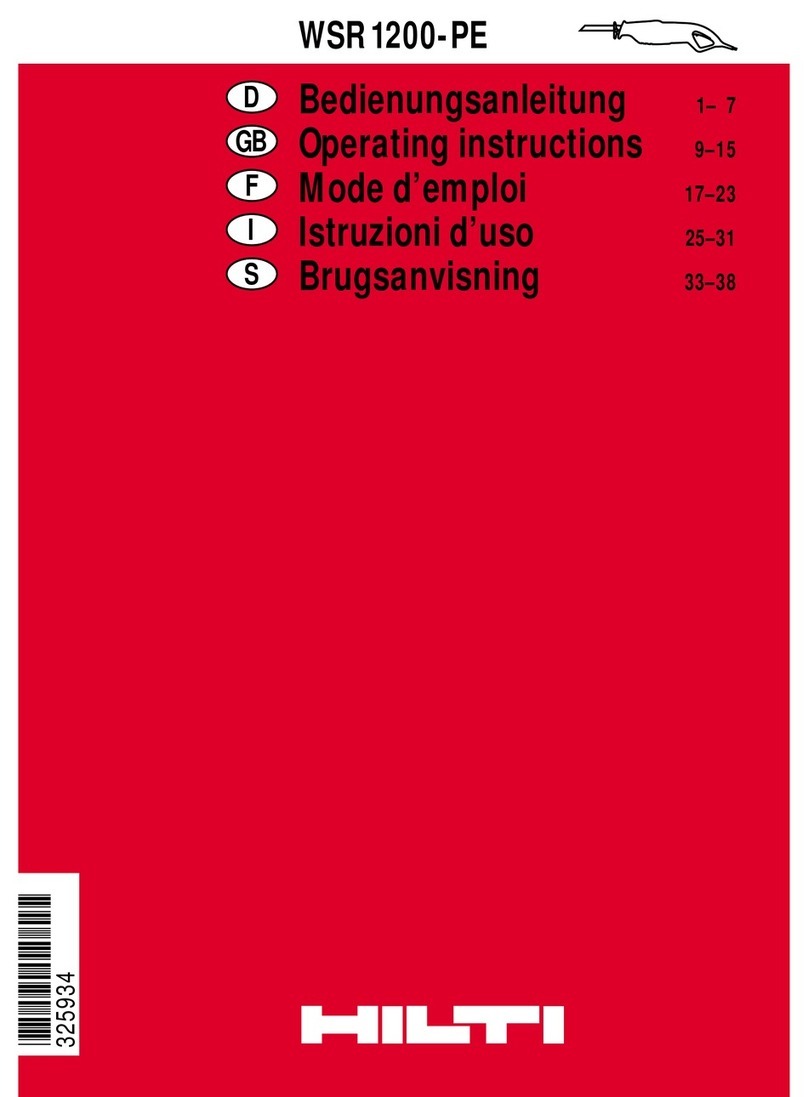
Hilti
Hilti WSR 1200-PE User manual

Hilti
Hilti NURON SC 4WL-22 User manual
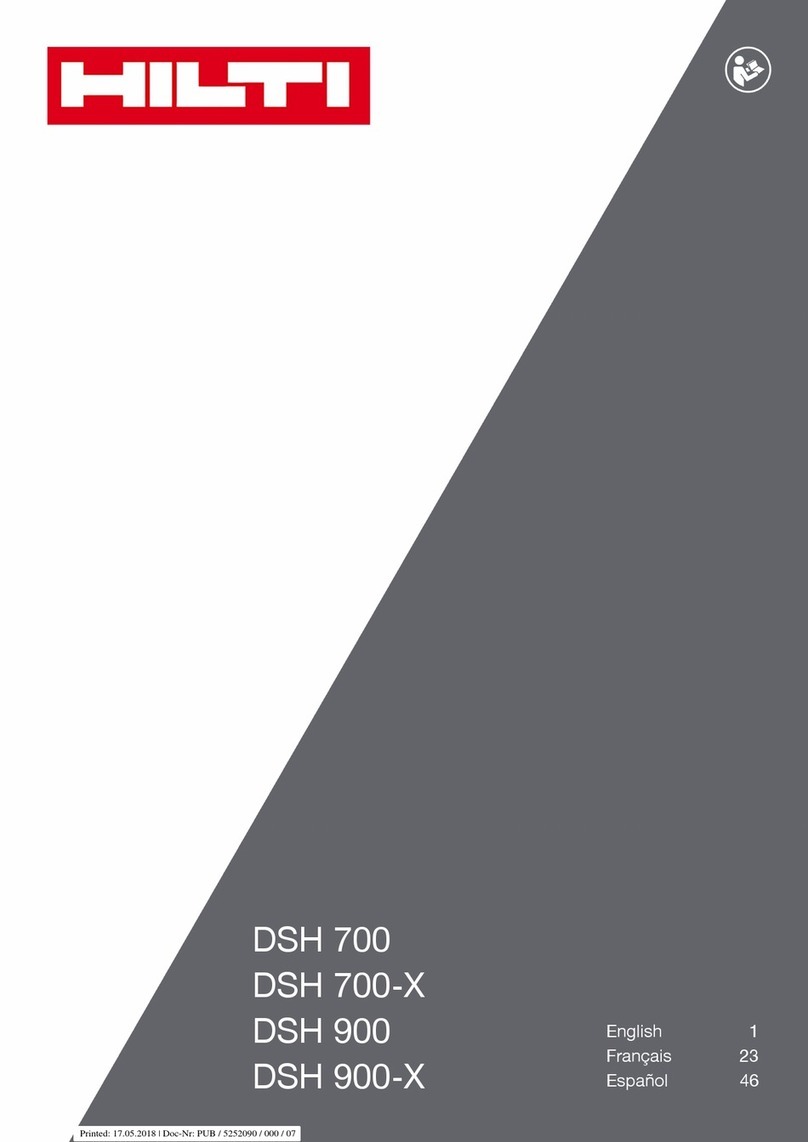
Hilti
Hilti DSH 700 User manual
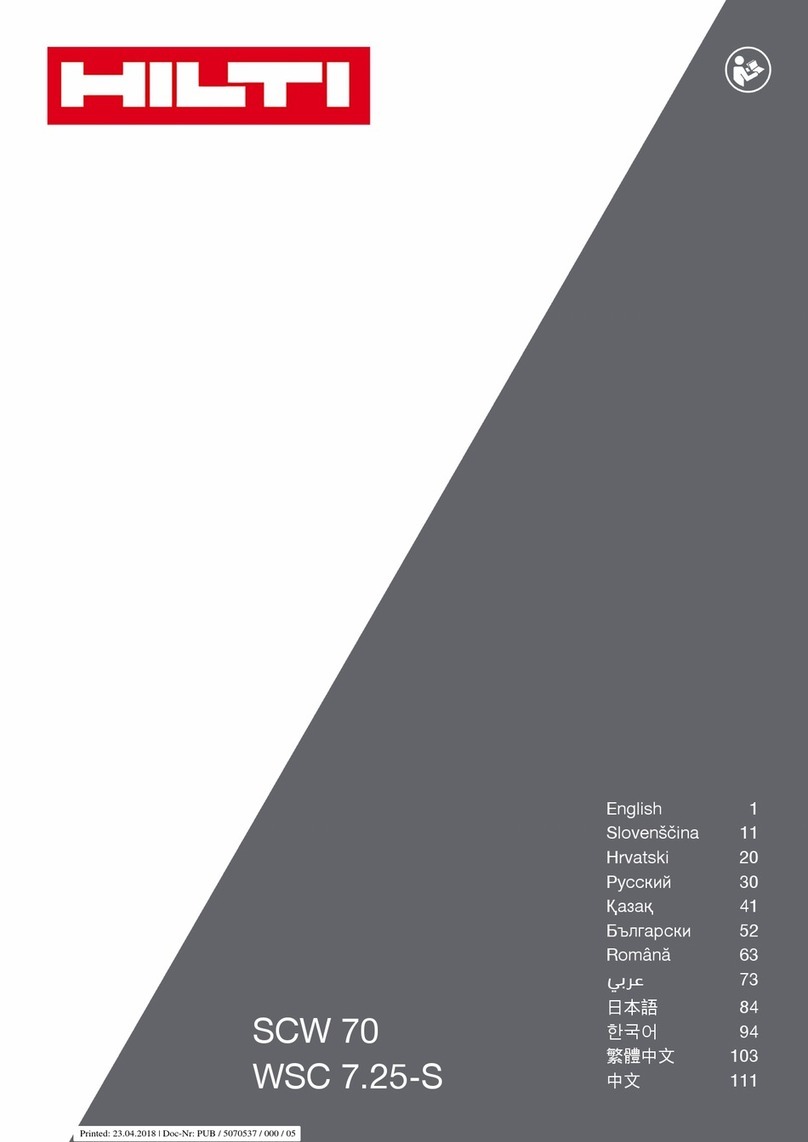
Hilti
Hilti SCW 70 User manual
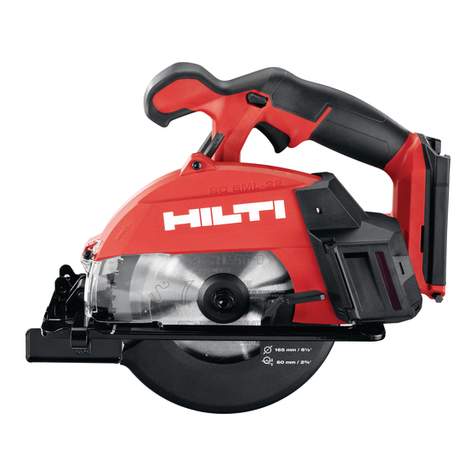
Hilti
Hilti Nuron SC 6ML-22 User manual
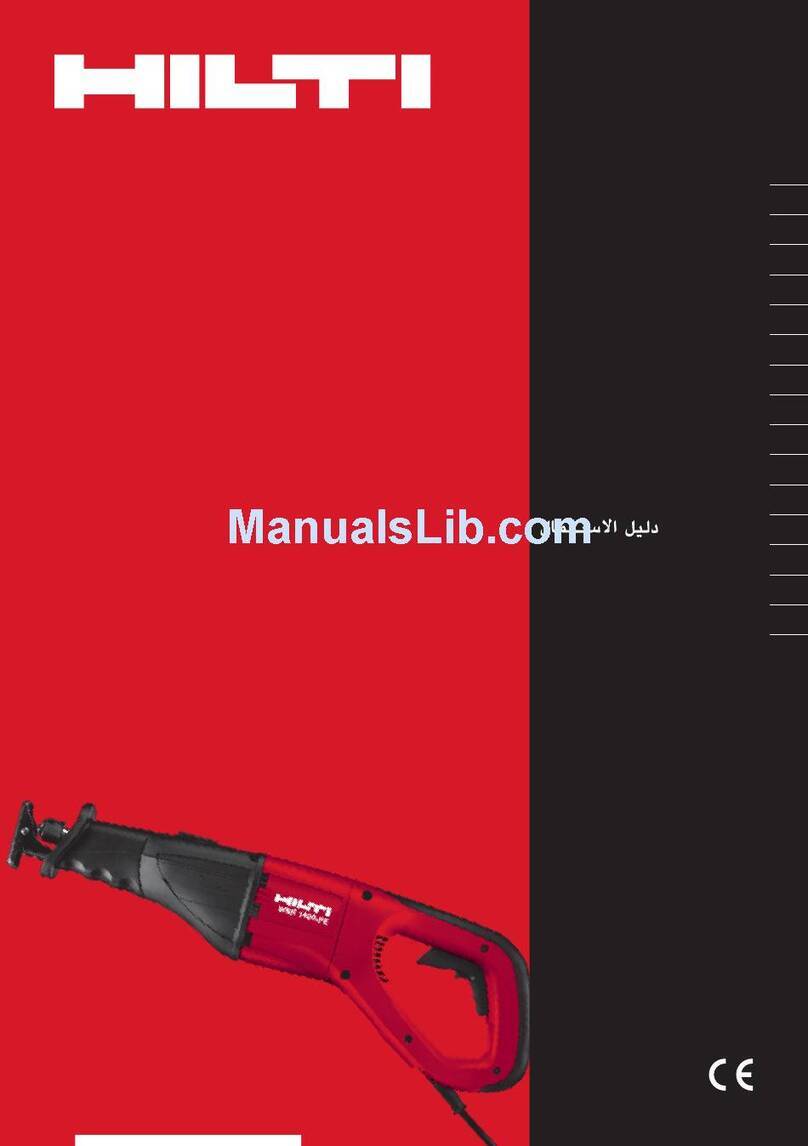
Hilti
Hilti WSR 900-PE User manual
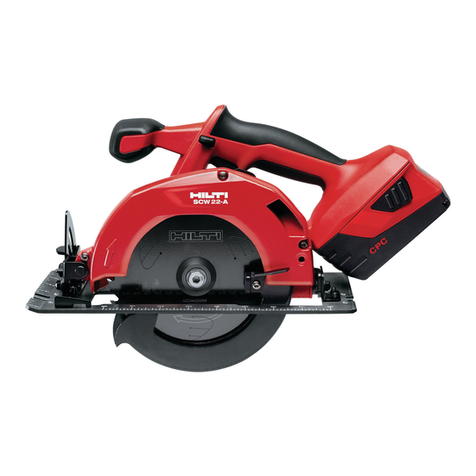
Hilti
Hilti SCW 22-A User manual
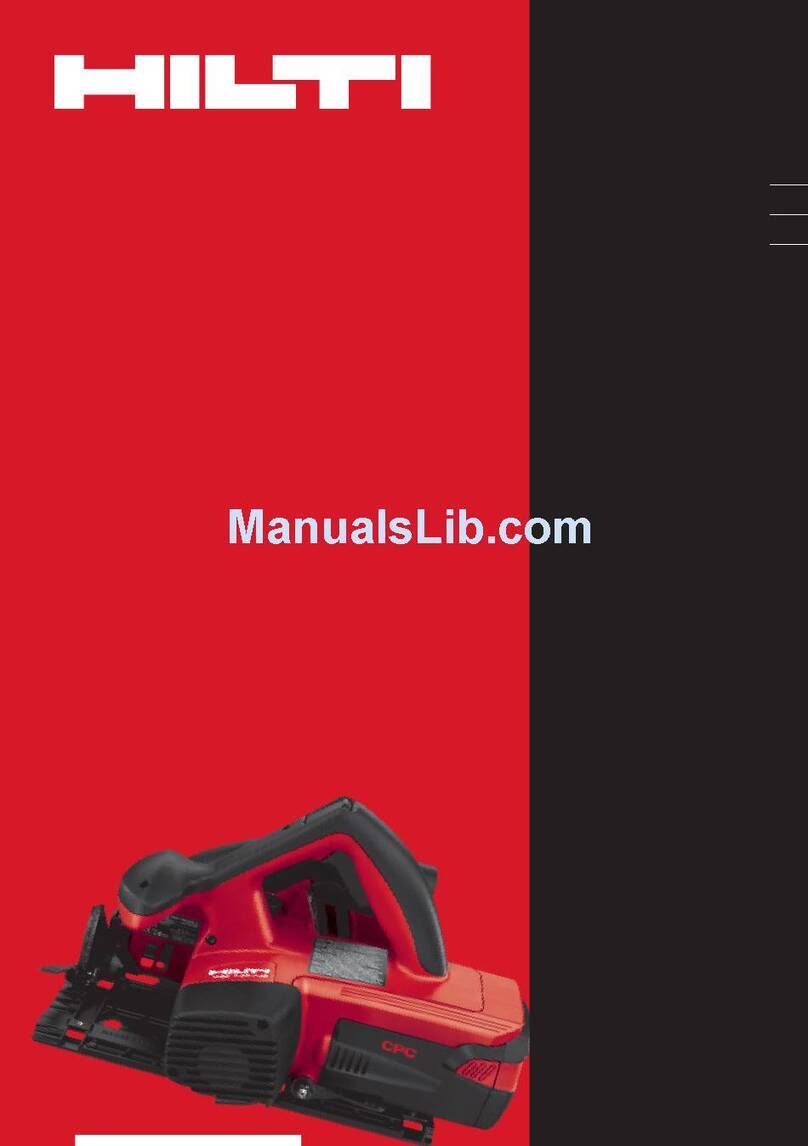
Hilti
Hilti WSC 7.25-A36 User manual

Hilti
Hilti WSC 85 User manual
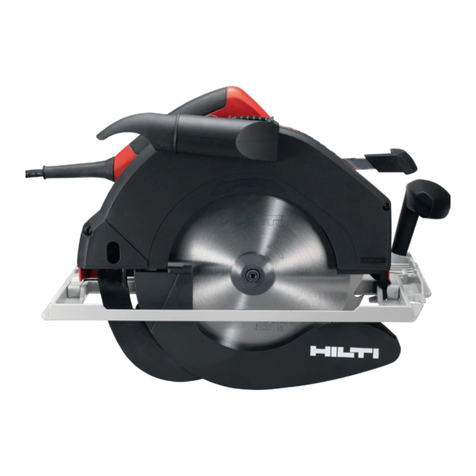
Hilti
Hilti WSC 85 User manual
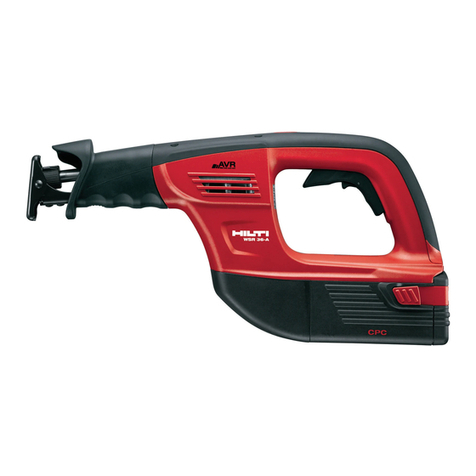
Hilti
Hilti WSR 36-A User manual

Hilti
Hilti SB 4-A22 User manual

Hilti
Hilti SR 2-A12 User manual
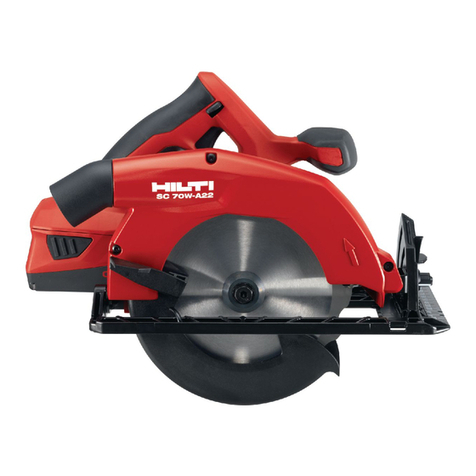
Hilti
Hilti SC 70W-A22 User manual

Hilti
Hilti SB 4-A22 User manual
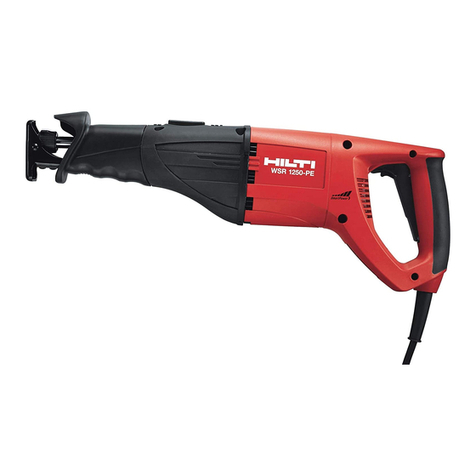
Hilti
Hilti WSR 1400-PE User manual
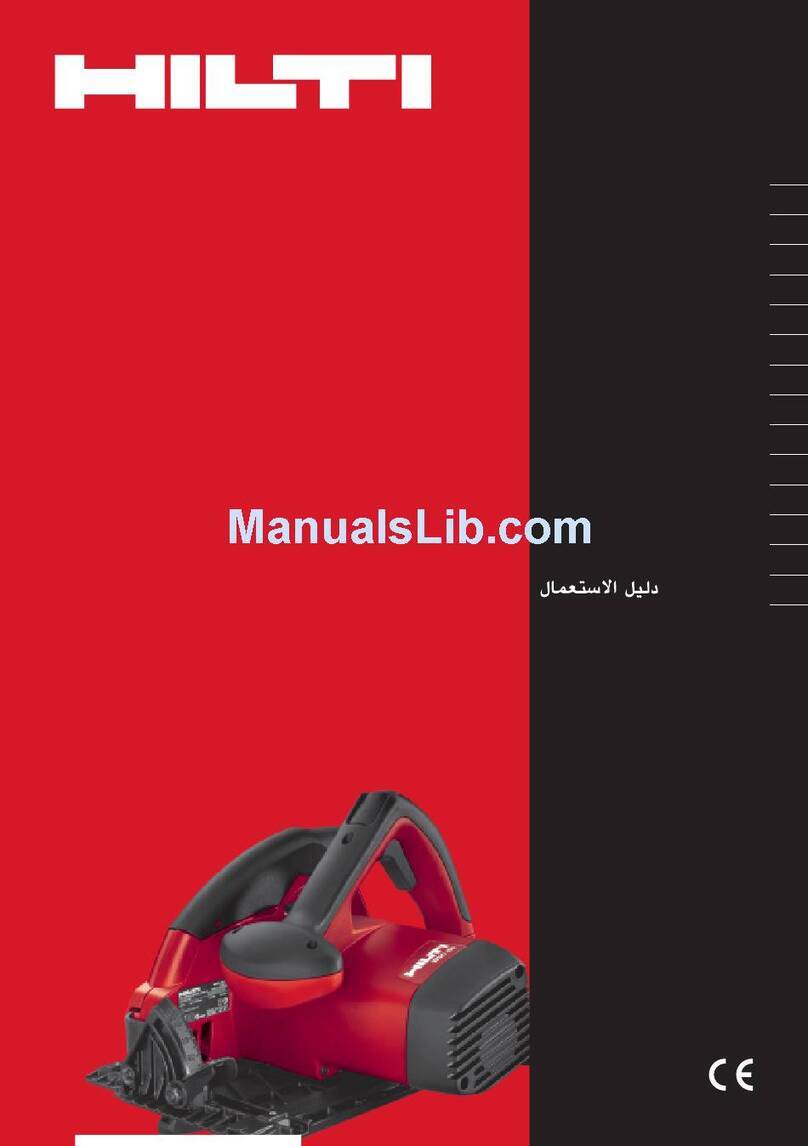
Hilti
Hilti WSC 70 User manual

Hilti
Hilti WSC 70 User manual

Hilti
Hilti AIC 600 User manual
